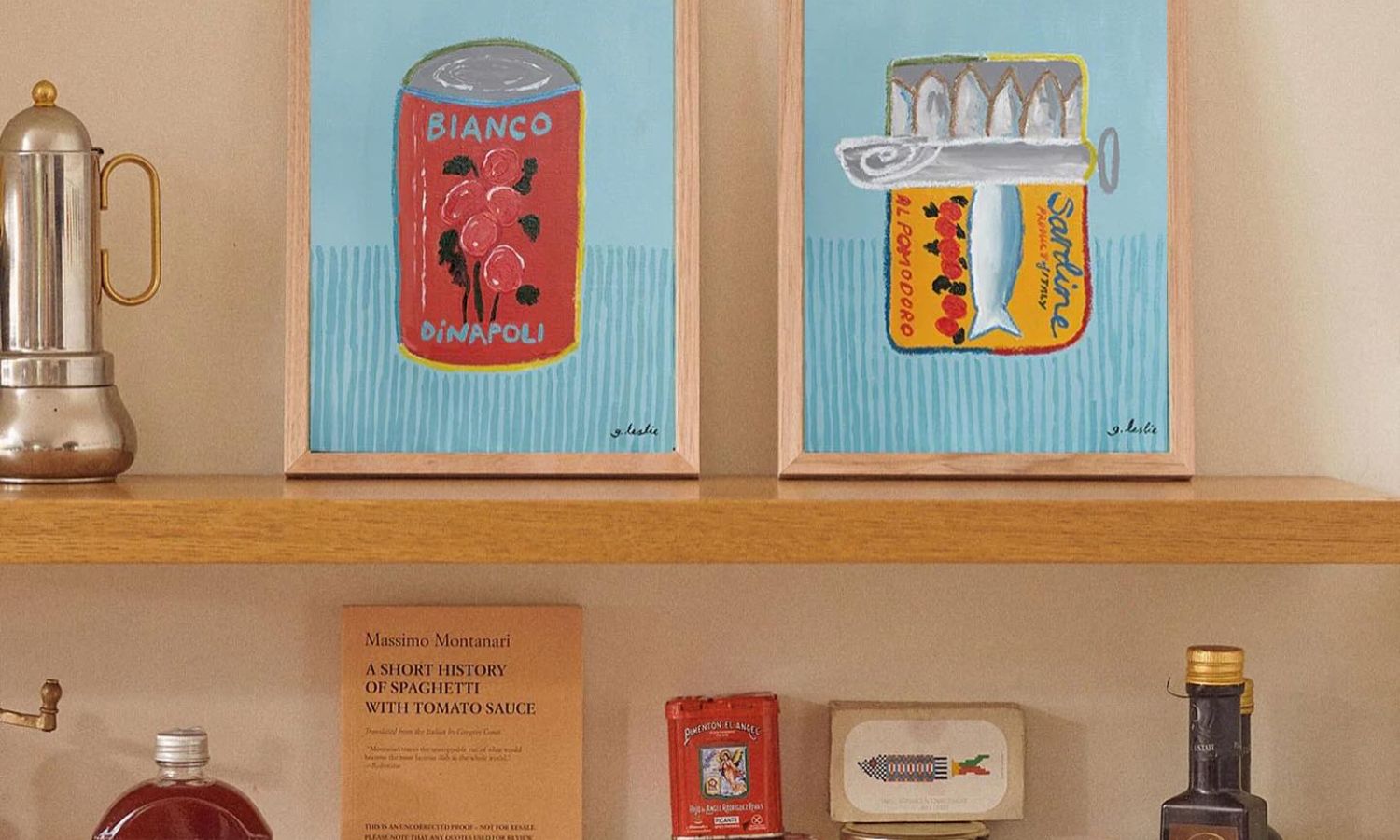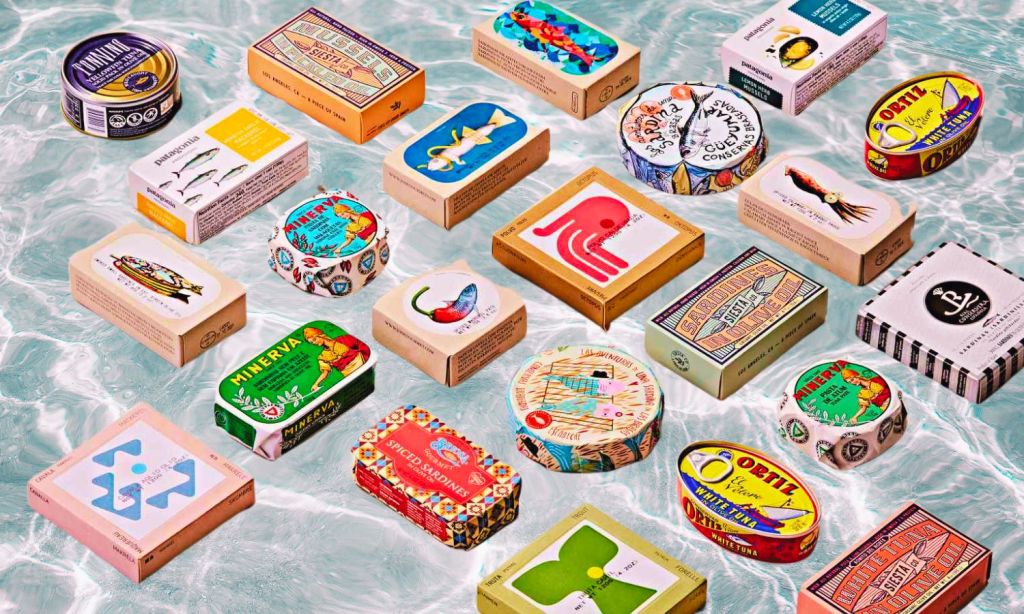If caviar is an emblem of wealth, then tinned fish is a badge of populism. At least, that’s how it used to be. Caviar, traditionally enjoyed via a bump or pearl spoon was once a delicacy reserved for the elite — those unflinching individuals capable of shelling out an entire week’s grocery budget on a 250g tin of fish eggs and a stack of fluffy blinis along with a handful of condiments without flinching.
Fast forward to today, caviar has shed its exclusivity, making its way onto every brunch menu, often served alongside fried chicken and a bowl of sea salt chips, while tinned fish is no longer relegated to the status of a humble pantry item. It has ascended to the ranks of the ‘fancy’ and even the ‘chic’ — a shift that speaks volumes about the evolving tastes and trends in the world of gastronomy and, so it seems, art (more on that later).
Continental Deli in Sydney’s CBD (and now Newtown) was, for a while, the go-to place to peel back a fancy tin stuffed with clams and sardines swimming in gold liquid. It was a luxury some were happy to indulge in, especially those who returned from the Mediterranean, where tinned fish is as common as a bag of salt and vinegar chips — similarly priced, too. Today, the deli has a section on the menu dedicated to the colourful, quality tins of fish. While it retains its leading position in the tinned fish arena, especially with the camera-friendly ‘Martini’ (tinned martini), it’s not alone in the game. Numerous restaurants and bars are popping tinned fish on the menu, serving it with crispy logs of bread, chunky bits of sourdough, and atop fried layers of potato.

Deux Frères in Sydney’s Quay Quarter Lanes is a new pintxos and tapas bar, bringing a taste of Basque to the city. According to its owner, Vincent Ventura, pintxos is a small snack usually served on a slice of bread, which is different from tapas, a miniaturised meal. “We tried over 30 brands and 40 cans of tinned fish — I’m sick of it now, but we knew it was important for diners to have the best option in Australia,” says Ventura.
For Ventura, the Basque way of eating tinned fish is to simply “put it on the slice of bread spread with espelette butter or on top of a patatas fritas — but only Bonilla a la vista ones (canned potato chips),” he adds.
In South Australia, a company called Little Tin Co. is canning sustainably caught Australian fish and seafood in classic tins. Owners Dan and Rachel Weeks saw a gap in quality, affordable tinned fish and decided to add an Australian brand to the game. They offer three tins: sardines in oil, smoky mussels in whisky and hot-smoked kingfish with vermouth pate. It even has commonplace art and illustrations on the covering, with an Aussie twist by local artist Ingrid Mangan.
If you’ve been wandering through the digital landscapes of food content, chances are you’ve encountered the tinned fish takeover. “Tinned fish date night” videos have stormed TikTok’s For You page, introducing a playful and inventive way to enjoy these ocean gems. The visual appeal and creativity surrounding these videos have turned tinned fish into a social media darling, drawing attention from food enthusiasts globally.
While some may argue that even the best tinned fish is just okay, the cool factor extends beyond taste. It’s about embracing the unexpected, celebrating culinary diversity, and turning a humble pantry item into a centrepiece of creativity and sophistication. For Melbourne artist Gemma Leslie, tinned fish was a muse for her latest series.
“I’m currently obsessed with portraying pantry items — I love how much they reveal about a person,” she says. Her artistic journey led her to paint a tin of sardines alongside a tin of tomatoes in a series aptly named ‘pantry staples.’ “I love zeroing in on the ‘everyday’ things that are often overlooked but can offer moments of beauty, like a beautiful tin or bottle.”
After scrolling through videos of people hosting tinned fish nights and showcasing their latest finds from specialty stores, Leslie saw an unexpected allure of tinned fish. “They went from being something that you forgot in the back of the cupboard to taking centre stage,” she says.

Although tinned fish has always been at the intersection of food and art, in some way or another, explains Leslie. “The tins themselves are tiny vessels of art,’ mentions Leslie. “In our Sardine Study, one metric we measured was the appearance of the tin. Portugal is known for its ‘conservas’ culture, and there is a whole archive dedicated to documenting beautiful and intricate tinned fish designs.”
Leslie admits, “Tinned fish is definitely an acquired taste.” “Bold flavours, smells, or textures are things that people are often averse to when they’re younger, and then people tend to get over these dislikes when they want to pursue more sophisticated flavours,” she notes. “The same thing goes for other foods like caviar and oysters.”
Leslie’s artwork, ‘Sardine Study,’ is one of the current best sellers on Food For Everyone and just so happens to be the most interacted post on Food for Everyone’s Instagram page. “It made us laugh a lot,” says Leslie; we thought it was a very silly review of a few tins of sardines, but it turned out to be our most successful post yet.”
“We reviewed them based on a whole range of factors like appearance (on a scale of gnarly to pretty) and their size (teeny to huge) because when trying unfamiliar foods, people can really be driven by appearance, not just taste.”
“Tinned fish is definitely cool again — just look at how many people want it on their walls.”
Related: Over Burrata? Fine, But What About the Stuff Inside?
Related: The Next Big Drink Trend Comes In Teeny Tiny Martini Glasses
Read more stories from The Latch and subscribe to our email newsletter.







